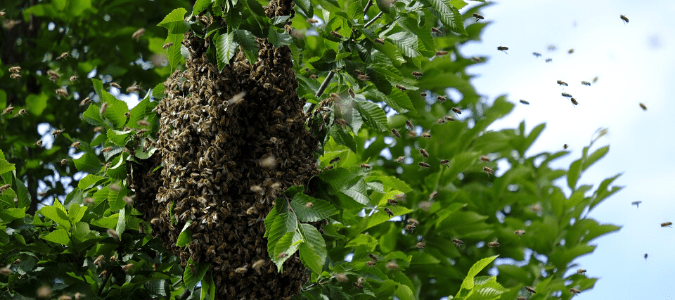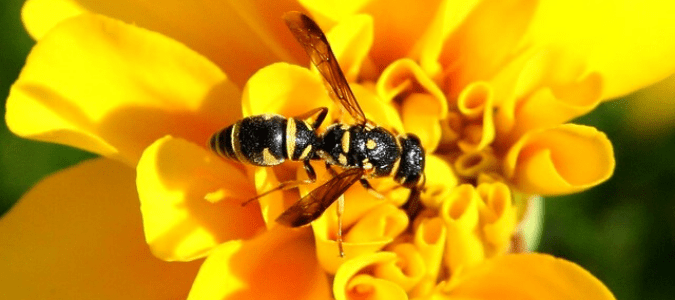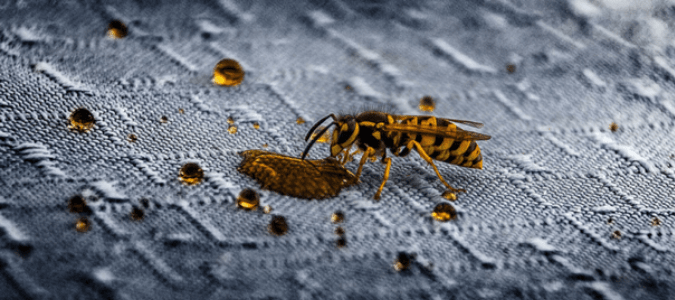
Bee and wasp stings are painful, so it’s easy to get nervous if you see a yellow and black creature flying around your yard–especially if they show up in areas where you and your family enjoy spending time outside. While not all of these insects are dangerous, many different types of bees and wasps look alike. It’s important to know what kind of insect you’re dealing with before you try to get rid of them. The safest way to deal with stinging insects is to contact a pest control professional. However, if you want to try to identify a bee hive or wasp nest on your own, there are a few precautions you can take to increase your safety.
Before you approach the focal point of bee or wasp activity, put on light-colored protective clothing like pants, a long-sleeved shirt and closed-toe shoes. To avoid attracting these insects, avoid wearing bright colors and wash off any fragrances you might have on your body, such as perfume, scented lotion or soap. Secure your hair and opt for less loose-fitting attire to reduce the chance that bees and wasps will get caught in your hair or clothes.
Slowly approach the area. Use your eyes to examine the nest or hive for distinguishing characteristics, while maintaining a safe distance. Some primary differences between bees and wasps include the appearance of their nests and the insects themselves.
Bees tend to have thicker, rounder bodies that appear fuzzy. Since bees primarily feed on pollen, you can usually find them around or on flowers. These insects usually don’t sting humans unless they feel threatened. Social bees, including bumblebees and honeybees, typically build their hives or nests in hollow or abandoned areas. You are more likely to find these hives in rodent burrows, thick grass, wall cavities, sheds or in trees, as you can see in the photo above. The main part of the nest is made of honeypots or wax cells produced by the bees. This waxy substance is a primary way to distinguish between bee hives and wasp nests.
Wasps typically have longer, thinner bodies with little or no hair. These creatures mainly feed on other insects and nectar. Wasps also sometimes scavenge for food and congregate around picnics, trash and other open food sources. These insects are more aggressive than bees and might sting repeatedly, even if they haven’t been provoked.
Social wasps, such as paper wasps and yellow jackets, often make their nests out of paper-like material, while other wasps, such as digger wasps, use a variety of building materials, including mud. Wasps usually build their nests in sheltered locations like in and around attics, doorways, patios, eaves, decks, porches or in the ground.
Both types of insects perform important jobs in nature. Bees pollinate flowers and crops and help them grow, while wasps help control populations of smaller insects and pests. However, bees and wasps can also pose a threat to humans and pets. They might sting, and even a single sting can be painful and even dangerous if someone is allergic.
If you find a bee or wasp nest in your yard or around your home, it’s safest to call a pest control professional instead of trying to remove it on your own. A specialist can correctly identify bees, wasps and many other types of insects and has the training and experience to advise you on your best next steps. Additionally, these specialists can typically leave you with tips on how to deter bees and wasps moving forward.
While most of us assume that all bees and wasps are social creatures, as we have explained, different types of wasps have different types of nesting areas and their behaviors can differ as well. If you have black and yellow wasps flying around your property and want to know more about these insects, keep reading for information that can help you determine exactly which type of wasp is making your property their own.

Black And Yellow Striped Wasp Identification
When you see black and yellow striped wasps in your yard, you might assume they’re all the same. However, there are many different kinds of wasps, each with their own distinct size and behaviors. Some of the more common types of wasps that have black and yellow markings are paper wasps, yellow jackets, mud daubers and Mexican honey wasps.
Paper Wasps
These wasps congregate in smaller colonies and are typically less aggressive than other types of wasps. Paper wasps are usually around one inch long and have very slender bodies with yellow or red markings near their head and abdomen. The legs of these wasps often hang down when they fly. Paper wasps make their nests out of chewed up wood fibers and build nests in umbrella-shaped cones under house eaves, porch railings, picnic shelters and other protected spaces.
Paper wasps usually don’t sting people unless they’re provoked. While they may look menacing, paper wasps can perform helpful functions like eating caterpillars and other pests. However, since they typically build nests near areas where we spend time, we can easily accidentally disturb a nest day. These stinging insects might swarm if they think you’re threatening their home.
Yellow Jackets
These insects are particularly dangerous for humans and pets because they are more aggressive and gather in large colonies. It’s easy to confuse these stinging insects with bees or paper wasps because of their markings and shape. However, yellow jackets have several distinguishing characteristics.
They’re a bit smaller than paper wasps–typically around a half-inch. As pictured above, they have a yellow and black striped pattern on their bodies, but they aren’t hairy or fuzzy like bees.
Their nests also look different. While they construct their homes out of paper-like material like paper wasps, yellow jacket nests are usually completely enclosed, with only a single hole for these creatures to enter and exit. These wasps sometimes build their nests under eaves and in areas like garages, wall cavities, porches and inside trees. They also tend to congregate around picnic areas, camps and trash cans and can attack humans when they’re looking for sugary food.
Yellow jackets most often make their nests in the ground. They build these subterranean homes in common areas like gardens and flower beds. Unfortunately for anyone who comes across these nests, they can contain up to 5,000 yellow jackets. If you approach a yellow jacket nest–even within a few feet of a nest when you’re walking or mowing your lawn–the wasps might consider this as a threat and you could become a victim of painful stings.
Mud Daubers
These wasps are less threatening than yellow jackets because they typically don’t sting unless provoked and they don’t swarm. Mud daubers are very similar in appearance to paper wasps and orange wasps, since they’re about one inch long and their bodies are very thin. However, their coloring is slightly different. These wasps are mostly black with some yellow markings on their legs or thorax.
The best way to know if you have mud daubers is to look at their nests. As their name implies, mud daubers make their nests out of mud. Like other wasps, they build their tube-like nests in protected areas near buildings like sheds, eaves and attics. However, mud dauber nests are usually smaller than those of other wasps because they’re solitary insects. Unlike social bee and wasp species, mud daubers don’t live with or build nests with other wasps.
These wasps mostly feed on spiders, including the venomous brown recluse and black widow varieties. While mud daubers typically don’t attack humans unless they’re provoked, if they do sting, it can be very painful.
Mexican Honey Wasps
These insects can be dangerous because they gather in large colonies. Mexican honey wasps look quite similar to other insects, as their bodies are dark-colored with yellow bands on their abdomen. However, these insects are much smaller than other wasps or bees–often just one quarter to one-third of an inch long.
Mexican honey wasps build paper-like, football or basketball-shaped nests in tree canopies. The nests are sometimes quite large and can hold as many as 18,000 wasps. These wasps feed on nectar and insects, and they are one of the only insects other than bees that make and store honey.
While Mexican honey wasps don’t usually attack people, if you knock their nest out of a tree or disturb it, the wasps will sting and might swarm. This leads us to a very common question—are wasps dangerous?

Are Wasps Dangerous?
Most wasps don’t sting humans and pets unless they’re provoked. However, since they live and build their nests in the same areas as people, wasps can be difficult to avoid.
When wasps do attack, their stings are usually just painful and heal on their own. While it is rare, wasp stings can be deadly if you are allergic. Unlike honeybees, wasps don’t die after they sting, so they might attack you repeatedly, increasing the chance of serious harm.
Wasps most often sting when they feel threatened. If you try to dislodge a nest or remove wasps on your own, they might see this as an attack and harm you in return. These insects might even perceive smaller movements as threats. For instance, if your child swings a newspaper to try to move the insect away from food or your dog runs past a nest, the wasps might feel threatened and react by stinging whoever is closest. Even your service providers might be at risk, as lawn service technicians can get stung while performing their regular mowing or tree trimming services.
You can find endless suggestions online of ways homeowners can treat or remove wasps on their own, including hitting, burning or drowning the nest, but these methods can be dangerous. Since wasps attack when they’re provoked, you might get stung repeatedly or damage your property if you try to remove them by yourself.
The best way to reduce the chance of wasps harming your family or pets is to work with a pest control professional to remove or treat the nests as part of a pest control treatment plan. These experts have the knowledge and resources to help keep you and your family safe.
ABC Can Protect You From Pests
Dealing with a bee or wasp population on your property can be overwhelming. Often, the easiest and safest way to handle either of these stinging pests is to contact a pest control professional. At ABC Home & Commercial Services, we offer customized pest control solutions to our customers and, based on your preferences, we can remove, treat or relocate the nest on your property. Then, we will seal up any potential nesting areas, or provide recurring preventative pest control services, so your worries can be put to rest and you can go back to enjoying your outdoor areas.